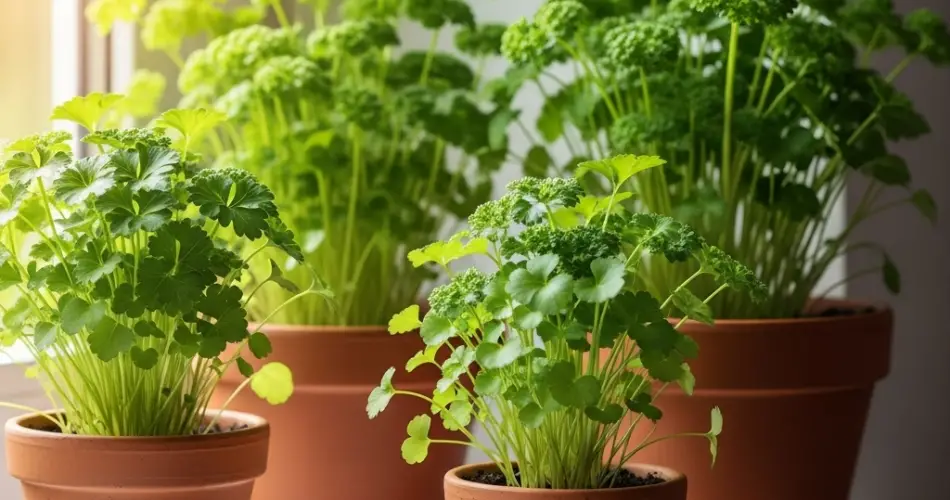Parsley is a classic kitchen herb that’s as easy to grow as it is to use. Whether curly or flat-leaf (Italian) parsley, this vibrant green plant is packed with flavor and nutrients, making it a perfect addition to salads, sauces, and cooked dishes. Best of all, parsley grows beautifully in pots—no backyard or large garden needed.
If you’re new to gardening or short on outdoor space, pot-grown parsley is a great way to start your own herb garden. With a little sunlight and regular care, you can harvest fresh parsley right from your windowsill, patio, or balcony. This beginner-friendly guide will walk you through everything you need to know.
Why Choose to Grow Parsley in Pots?
Parsley is an ideal herb for container gardening. Its compact size and relatively shallow root system mean it doesn’t need a lot of space. Growing it in a pot allows for better control of soil, watering, and placement. Plus, having fresh parsley close to your kitchen makes harvesting quick and convenient.
Benefits of pot-grown parsley include:
-
Easy access for cooking
-
Fresh, pesticide-free herbs
-
Simple maintenance and control
-
Great for indoor and outdoor spaces
-
Suitable for small apartments or balconies
Choosing the Right Pot
Parsley prefers a container that allows room for root development. Choose a pot that’s at least 20 cm (8 inches) deep and wide, with good drainage holes at the bottom. Clay, ceramic, or plastic containers are all suitable.
If you plan to grow more than one plant or want a bushier harvest, consider using a wider planter or window box. Ensure the container sits in a sunny location—either indoors near a bright window or outside where it receives several hours of sunlight daily.
Best Soil for Parsley
Parsley thrives in rich, well-draining soil. A quality potting mix designed for vegetables or herbs works well. For even better results, mix in a little compost or aged manure to boost nutrients and moisture retention.
Avoid heavy garden soil or soil that compacts easily, as this can suffocate the roots. The ideal soil pH for parsley is between 6.0 and 7.0.
Starting from Seeds or Seedlings
Parsley can be grown from either seeds or young nursery plants. Growing from seed is more affordable but requires a bit of patience.
To grow parsley from seed:
-
Soak the seeds overnight to soften the outer shell and improve germination.
-
Fill the pot with moistened soil.
-
Sow the seeds about 0.5 cm deep and lightly cover them with soil.
-
Keep the soil consistently moist but not soggy.
-
Place the pot in a warm, sunny spot.
Germination can take 2–3 weeks, so be patient. Once seedlings emerge, thin them out so each plant has space to grow.
If using seedlings, gently transplant them into your container, spacing them about 10–15 cm apart. Water well after planting.
Light and Temperature
Parsley loves sunlight. It needs at least 5 to 6 hours of sun per day. A south-facing window is ideal for indoor plants. Outdoors, choose a spot that gets morning sun and some afternoon shade in hotter climates.
Parsley can tolerate cooler temperatures and grows best between 15°C and 25°C (59°F–77°F). It can survive light frosts, but extreme cold may damage the plant.
Watering and Feeding
Parsley prefers evenly moist soil. Water when the top inch of soil feels dry to the touch. Avoid letting the soil completely dry out, especially during hot weather.
Feed your parsley every 3–4 weeks during the growing season with a balanced liquid fertilizer or organic compost tea. Avoid overfeeding, as too much fertilizer can lead to lush leaves with reduced flavor.
Harvesting Parsley
Once your plant reaches about 15–20 cm tall, you can begin harvesting.
-
Use scissors to snip outer stems at the base.
-
Always harvest from the outer edges, leaving the center intact so the plant continues to grow.
-
Don’t remove more than one-third of the plant at a time.
Regular harvesting encourages more growth and keeps the plant from becoming leggy.
Freshly cut parsley can be used immediately in recipes or stored in the refrigerator. For long-term storage, dry the leaves or freeze them in ice cube trays with a little water or oil.
Common Issues and Tips
-
Yellow leaves: May be a sign of overwatering or poor drainage. Let the soil dry out slightly before watering again.
-
Leggy growth: Often due to inadequate sunlight. Move the plant to a sunnier location.
-
Slow growth: Parsley naturally grows slowly at first. Be patient and avoid overwatering or overfeeding.
To extend the plant’s life and delay flowering, pinch off any flower stalks that start to form. Once parsley goes to seed, it typically stops producing fresh leaves.
Conclusion
Pot-grown parsley is a rewarding and simple way to enjoy fresh herbs at home. Whether you’re garnishing a dish or adding a flavorful touch to a recipe, having parsley just steps away makes cooking more convenient and enjoyable. With basic care and a little attention, even beginners can grow lush, vibrant parsley in containers—no garden required.



